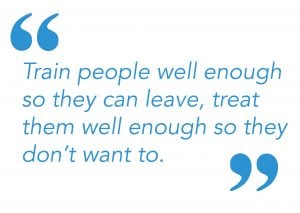It’s a new year, and you’re determined to take on some of your toughest challenges early in the year. Mistakes and misses may have cost you last year, but this year is going to bring big changes to your sales strategies and customer alignment. You can start by looking at how you’re doing in the following three areas. Modifications made in these areas have the ability to create big changes when it comes to your bottom line.
Retaining Top Sales Talent
Billionaire business magnate Richard Branson has said, “Train people well enough so they can leave, treat them well enough so they don’t want to.” This is especially great advice for sales leaders; since, according to Harvard Business Review, estimates of annual turnover among U.S. salespeople run as high as 27%—twice the rate in the overall labor force. These sales leaders would be wise to put in the extra effort it takes to attract and retain top sales talent, beginning with Branson’s advice—training.
So many organizations drop the ball when it comes to training, especially ongoing training. They onboard and educate their new recruits on the product or solution but neglect to continue that instruction. One-on-ones get pushed aside. E-learning is considered too time consuming and outside training too costly. They don’t realize that proper training is a huge retention strategy.
Training is going to make your salespeople better at selling—and while they’re in your employ, better at selling your products and solutions. Even if some don’t stick around for the long haul, wouldn’t you rather have knowledgeable, skillful, and innovative salespeople working for you? Proper training is a win win and well worth the time and investment.
Training isn’t the only important strategy to employ if you want to keep those top sellers. Consider your sales culture. Is it a positive and motivating environment? Do the new people you’re bringing in fit the culture you’ve worked hard to build? Or, do you need to make modifications to improve it? Make sure you’re not losing great salespeople simply because you’ve dismissed the idea that culture is important.
Technology is another essential part of your overall efforts. Does your sales team have the tools they need to do the best job they can? If they’re not using the technology you’ve provided, have you questioned why? Or, are they using the technology but getting poor results? Finding the technology that works best for your team can be overwhelming, but it is completely necessary if you want to hold on to your great salespeople and attract others like them.
Technology Used in the Sales Process
Speaking of offering your sales staff the right technology, what is the “right” technology or technologies? Whether they are overwhelmed by the vast options, lack the time to review, or aren’t sure what’s appropriate for their particular team, many sales leaders struggle when deciding on the proper technology stack for their salespeople.
We suggest you begin by:
- Focusing on your buyer’s journey. What tools are going to assist and allow your sales force to meet buyers at the right spot in the sales cycle?
- Examining your processes and removing any redundancies or inefficiencies before looking for what technology you need to support and streamline those processes.
- Assessing your current tech stack. Are you getting true value out of the tech tools you’re using? Make sure you get your super users involved in the discussion.
There is so much more I could write here, but Is It Time to Rehab Your Sales Enablement Strategy? is a great blog that covers this topic well.
Upselling and Cross Selling
A final thought for creating significant change to your bottom line is to make sure you’re not throwing away opportunities with current customers. According to Forrester, upselling can bring in up to 30% of your revenue. That’s huge; especially considering you’re making sales without having to put in the time it takes to acquire a new customer.
However, in order to upsell and cross sell, you do need to maintain a great relationship with those current customers and know their specific goals and KPIs when it comes to using your products or solutions. If you truly understand and can speak to their challenges and objectives, you’ll show that you have their best interests in mind when you attempt to upsell or cross sell your current accounts.
To get started, look at your underperforming accounts. What percent of market share do you own with these? Which products or services can be leveraged across these customers’ other business units? Profile, segment, and score your accounts to understand your governing sales process. Using data to drive your sales cadence can help you get straight to the questions relevant to your sales play.
Want Some More Help?
If you’ve read this blog and feel overwhelmed or believe you need more help in these areas, please reach out. We’ll conduct a free assessment to see if a partnership with MarketSource might be the quickest way to a more robust bottom line.


